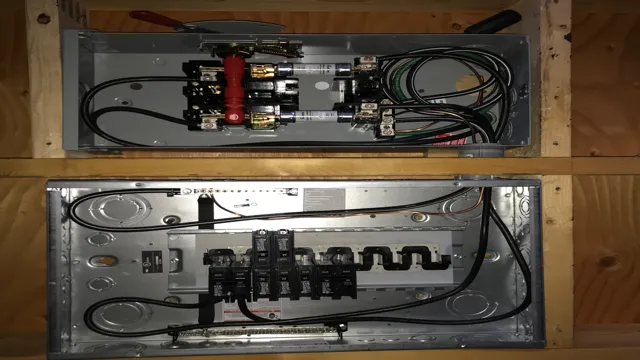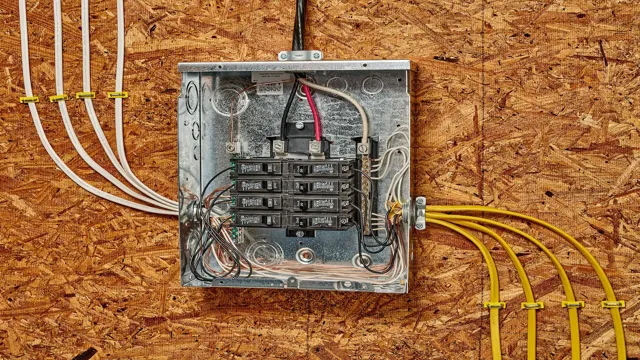If you’re planning on installing a 100-amp sub panel, proper grounding is essential to ensure the safety and functionality of your electrical system. Grounding is the process of connecting electrical devices and circuits to the earth, providing a safe path for stray electrical currents to travel. Without proper grounding, electrical faults could cause electrical fires, electrocution, and damage to electronic equipment.
In this blog, we’ll discuss the importance of proper grounding and outline the steps you need to take to ensure your sub panel is properly grounded for maximum safety and efficiency. So, let’s dive in!
Determining the Ground Size
When it comes to determining the ground size for a 100 amp sub panel, there are a few factors to consider. First and foremost, you’ll need to check the local electrical code requirements. Generally, for a 100 amp sub panel, you’ll need a grounding conductor that is at least #8 AWG copper or #6 AWG aluminum.
This conductor will need to be connected to an approved grounding electrode, such as a driven rod or a buried plate, to ensure safe operation. It’s crucial to follow the guidelines set forth by your local authorities to avoid any safety issues or code violations. Additionally, it’s important to ensure that the grounding electrode is located in a dry area that’s easily accessible for maintenance purposes.
Taking these steps will ensure that your 100 amp sub panel is properly grounded and safe for use.
Confirm the Type of Wiring and Panel
Determining the ground size is a crucial step in confirming the type of wiring and panel for your electrical system. The ground wire serves as a safety measure that connects to the earth, preventing electrical shock in the event of a short circuit or other electrical malfunctions. To determine the size of the ground wire needed for your specific electrical system, you must consult the National Electrical Code (NEC) or a qualified electrician.
The NEC outlines the minimum size requirement for ground wires based on the size of the main disconnecting means, conductor size, and type of insulation used. It’s essential to ensure that the ground wire is properly sized to ensure the safety of your household and avoid any potential damage that could occur from electrical faults. Don’t underestimate the importance of determining the ground size and seek expert advice to ensure your electrical system is up to code and safe for use.

Check the Local Building Codes
When it comes to building a new structure, it’s important to familiarize yourself with local building codes to ensure a safe and legal project. One important aspect of this is determining the appropriate ground size for your building. This can vary depending on the location and the intended purpose of the structure.
For example, a residential home may have different requirements than a commercial building. It’s important to consider factors such as soil type, slope, and drainage to determine the appropriate size. Taking these factors into account can ensure that your structure is safe and meets all necessary regulations.
By following local building codes and properly determining your ground size, you can ensure a successful and legal building project.
Calculating the Minimum Ground Size
When it comes to determining the minimum ground size for a 100 amp sub panel, there are a few factors to take into consideration. The National Electrical Code (NEC) requires that the ground wire be at least as large as the branch circuit supplying the sub panel. In this case, a 100 amp sub panel would require a minimum of 4 AWG copper or 2 AWG aluminum ground wire.
However, it’s important to also consider the type of wire being used for the branch circuit and the distance between the main panel and sub panel. Heavy loads and longer distances may require a larger ground wire to ensure proper grounding and safety. It’s always best to consult with a licensed electrician to ensure your installation meets all necessary code requirements.
Consider the Length of the Circuit
When designing a grounding system, one of the most important considerations is the length of the circuit. This is because the farther the current has to travel, the stronger the electrical resistance becomes. As a result, the grounding system needs to be able to handle the increased load.
To calculate the minimum ground size needed, several factors must be taken into account, including the length of the circuit, the type of soil, the amount of moisture present in the ground, and the maximum current that is expected to flow through the circuit. It’s also important to remember that a grounding system is not a one-size-fits-all solution, and the size and design of the system will vary depending on the specific application. Overall, before installing any grounding system, it’s important to consult with a qualified electrician to ensure that the system is designed to meet your specific needs.
Calculate the Sub Panel Load
Calculating the minimum ground size is a critical step in installing a subpanel in your home. The ground size ensures that any electrical faults in the subpanel are quickly detected and directed towards the ground, preventing damage or injury. To calculate the minimum ground size, you need to determine the load rating of the subpanel and the length of the grounding conductor.
The National Electric Code (NEC) specifies that the minimum ground size should be based on the maximum overcurrent protection device rating and the size of the conductor. For example, a subpanel with a maximum rating of 100A would require a minimum #8 ground wire. The NEC also provides a ground wire sizing table that specifies the minimum ground size based on the subpanel’s load rating and conductor length.
It is essential to adhere to the NEC guidelines when calculating the minimum ground size to ensure that the subpanel operates safely and efficiently.
Use Grounding Table from NEC
When it comes to electrical work, safety is key. And one of the most important aspects of electrical safety is ensuring that the ground wire is of the appropriate size. This is where the Grounding Table from NEC (National Electric Code) comes in handy.
The table provides guidelines on the minimum size of the ground wire based on the size of the electrical equipment or conductor. It takes into account factors like the current-carrying capacity, conductor material, and the type of installation. By using this table, you can ensure that the ground wire in your electrical system is able to safely carry fault current and protect you from electrical shock.
So, don’t skip this important step in your electrical work. Just consult the Grounding Table from NEC and calculate the minimum ground size for your project.
Choosing the Right Cable
When it comes to installing a 100-amp sub-panel, it’s crucial to choose the right cable size for the ground connection. The size of the ground wire is determined by the amperage of the panel and the length of the cable run. For a 100-amp sub-panel, a #8 AWG copper wire is recommended for the ground connection, but it’s always best to consult local codes and regulations to ensure compliance.
Installing the correct cable size for the ground connection is essential for safety and proper function, as it helps prevent electrical fires, shorts, and other hazards. Whether you’re an experienced electrician or a homeowner embarking on a DIY project, it’s essential to familiarize yourself with the best practices for grounding a 100-amp sub-panel to ensure your electrical system is safe, reliable, and up to code.
Consider Copper or Aluminum Cable
When it comes to choosing the right cable, there are many options available in the market. But, copper or aluminum cables are certainly worth considering due to their durability, flexibility, and cost-effectiveness. Copper cables are widely used in electrical applications because they are highly conductive and can transmit data over long distances with minimal signal loss.
On the other hand, aluminum cables are less expensive and lighter than copper cables, making them a perfect choice for industrial installations. Moreover, they have excellent temperature resistance, making them suitable for high-temperature environments. Both copper and aluminum cables have their own unique benefits, and choosing between them depends on your specific requirements.
However, whatever type of cable you choose, make sure to get it from a trusted supplier to ensure quality and reliability.
Check the Insulation Rating
When it comes to choosing the right cable for your electrical wiring needs, one important factor to consider is the insulation rating. This refers to the level of protection that the cable’s insulation provides against electrical leaks, short circuits, and other hazardous events. A cable’s insulation rating is typically expressed in volts and refers to the maximum voltage that the insulation can handle without breaking down.
Choosing a cable with the appropriate insulation rating for your application is crucial to ensuring safe and reliable performance. It’s important to consult with a qualified electrician or supplier to determine the appropriate insulation rating for your needs. Don’t compromise on safety when it comes to choosing cables – always take insulation rating seriously to prevent dangerous electrical incidents.
Conclusion
In conclusion, choosing the right size ground for a 100 amp sub panel is crucial for ensuring the safety and efficiency of your electrical system. Don’t skimp on the size of your ground, as a small mistake could lead to big problems down the line. Remember, when it comes to electrical work, it’s always better to be safe and grounded than sorry.
“
FAQs
What is the minimum size ground wire for a 100 amp sub panel?
According to the National Electric Code (NEC), a #8 copper wire is required for the ground wire of a 100 amp sub panel.
Can a 100 amp sub panel be installed outside?
Yes, a 100 amp sub panel can be installed outside as long as it is housed in an appropriate outdoor-rated enclosure.
How many circuits can a 100 amp sub panel handle?
The number of circuits a 100 amp sub panel can handle depends on the amperage rating of each individual circuit. Generally, a 100 amp sub panel can handle up to 20 circuits.
What size conduit do I need for a 100 amp sub panel?
The size of conduit required for a 100 amp sub panel depends on the number and size of the wires being run. Generally, a 2-inch conduit is suitable for a 100 amp sub panel.
Can a 100 amp sub panel be used as a main panel?
Yes, a 100 amp sub panel can be used as a main panel if it has an appropriate main breaker or disconnect in place.
What is the maximum distance a 100 amp sub panel can be located from the main panel?
The maximum distance a 100 amp sub panel can be located from the main panel depends on the size of the wire being used. Generally, a #3 copper wire can be run up to 100 feet before voltage drop becomes an issue.
Can I install a 100 amp sub panel myself?
It is recommended that a licensed electrician perform any electrical work, including installing a 100 amp sub panel. However, if you are knowledgeable and experienced with electrical work, you can install a 100 amp sub panel yourself as long as you follow all safety guidelines and local codes and regulations.






